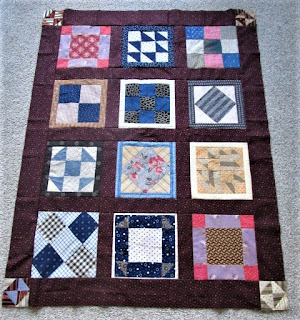It was in the early 1990s that I became interested in really learning about "old" fabrics. I have been collecting quilt tops and quilt blocks since then. Now it has been fun to preserve these vintage quilt blocks by making them into small quilt tops.
The blocks that were used in my latest quilt top were chosen because they were a similar size--by bordering most of them out, I could size them all to 8 1/2".
But as I worked with these particular blocks, I realized that they represent just WHY I started collecting: From blocks and unfinished tops I could study types of fabrics as well as piecing techniques.
In general, these blocks contain fabrics from the time period of 1880-1920.
There are Double Pinks and fugitive purple (dull in color and blotchy) in this corner block:
A black (mourning) print and cadet or "soldier" blue were used in this 9-patch block:
Brown prints of the mid-late 1800s are called "madder" browns, and are in the corner blocks of the border of my little quilt:
Navy background with white prints are typical of this era, as are shirtings--small prints on a light background. The small triangle fabrics in this block are mourning prints:
In my studies, I was surprised to learn that ginghams and wovens were popular during that time period. This block features two different checks plus cadet blue:
And I discovered that some fabrics produced around 1900 are thin, almost like cheesecloth! The shirting in this block (that also contains mourning prints) has an area that is VERY thin!
A variety of techniques were used to piece these blocks. A couple of them were pieced by machine. Most were pieced by hand, seemingly with quilting thread. The running stitch used was small and very regular in some blocks; in others, crude and uneven. Two of the blocks were pieced with a back stitch all along the seam.
Our quilting "fore-mothers" did not remove the selvages from the fabrics they used. And often they pieced chunks of fabric together to make a piece large enough to fit where needed. A section of the scrappy nine-patch block was not large enough, so instead of replacing the entire corner square, I merely pieced in some vintage fabric so I could trim the corner to the size needed.
This project, then, is the perfect study of vintage fabric. If I decide that this top should be quilted, all of these "clues" will be hidden! Perhaps a good use for this quilt top would be to leave it as is and print out all of this information to go with it from which future quilters can learn?










